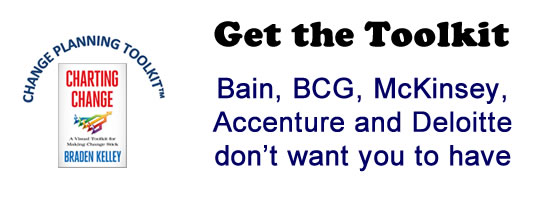Three Tips on Organizational Change

The essence of timing, improvisation and exiting the realm of reason
Leading innovation in organizations calls for changing strategies (objectives, business models), structures (processes, systems, hierarchies and ways of working) and cultures (behaviors, attitudes and organizational norms). Some attempts at deep transformational change succeed (IBM and Whirlpool are well documented) and many fail (Kodak and Borders books come to mind). The failures are often because of bad timing, skillsets that cannot cope with the unknown and an unreasonable imprisonment within the realm of reason. Here are three tips to overcome these challenges.
Tip #1: Set the pace and stick to it
Timing is always of the essence when change is effected in organizations. Keeping a lookout on what is going on out there and reasoned judgment on what new things are on the way are vital for strategic planning. Changes in the business context are of course beyond any single company’s control.
To forge a new strategy and gain competitive advantage in a new business context, especially one that is greatly affected by digitalization and new technology in its many forms, established companies must also transform themselves internally. This might mean extensive firing and/or hiring, redeployment, new jobs with new work content, new chains of command and changing the content and form of communication with clients and colleagues. Change is always disruptive in that, for a period, the organization will be working both in the old way and the new way.
In the process not all people will be equally happy because people have different rates of resisting, accepting or adopting change. Crisis management nearly always requires more directive leadership (and less time to discuss) whilst anticipative strategies can be more participatory. In any case setting a pace for the new way to completely replace the old way is essential and, in general, fast is better than slow.
Once decided, deadlines must be sacred. Working on a time schedule gives people who are working on change a sense of purpose while disruption and unhappiness become more palatable and easier to cope with. A decision which is not implemented becomes an excuse for a second decision to remain on the shelf too.
Tip #2: Improvise according to plan
Transforming a vision into a strategy, a strategy into projects and projects into action are all important elements in the top-down part of the change process. There comes a time when a bottom-up approach becomes inevitable as new people who are called to implement the planned change bring in new perspectives that might modify the plan. Sometimes a detail which the high-level planners are unaware of can, in practice, be a showstopper.
Leaders cannot be content with just setting the destination, they must also act as explorers, navigators, captains and admirals in a journey with much uncertainty. Both personal and collaborative creativity are crucial in making sure the many unanticipated challenges that crop up on the way are resolved in imaginative ways. In fact much value might come from (seemingly) small, on-the-spot ideas and decisions.
Improvisation becomes a most valuable skill in these circumstances. Responding to new situations quickly does not void the need for a plan. Like stage improvisers, who usually act around a set basic framework and norms, people in organizations should themselves judge when to stick to a plan and when to make up things to modify the path. Like impromptu performers, they must be very aware of timing. Their voyage will become a collective experience a team creation. Making people active in this creation and proud of the outcomes is hugely important.
Improvisation can cause both discomfort and excitement. Training for creativity and teamwork will help people overcome the barriers in their minds as they move into new and as yet unexplored territories.
Tip #3: Exit the realm of reason
Organizational change is very difficult, if not impossible, without personal change from many people and, it goes without saying that those leading the change must be ready and able to change themselves. But is rational argument sufficient to convince the skeptics out there and inside each and every one of us? Certainly not.
Old-fashioned economists would make the (preposterous) assumption that all people are always rational. Their models were based on ideas such as money being the single motivator of people at work and trading on stock exchanges is the outcome of logical and explainable behaviour. Behavioral economists, most famously the Nobel prize-winning Daniel Kahneman, have since shown otherwise. Human beings are in fact a complex mess of reason, emotions and fantasies.
Twenty years ago John Kotter a Harvard Business School academic published an 8-step model for implementing change: Create urgency, build a team, create a vision, communicate the vision, remove obstacles, go for quick wins, let the change mature, integrate change in the organization’s way of life. Each step is based on good reasoning but successful implementation is possible only with a high-level of awareness of the human factors in play.
An alternative approach published recently (“The irrational side of change management†– McKinsey Quarterly, Carolyn Aitken and Scott Keller) offers different advice. Begin by creating a story and call for all people to tell the story from their own viewpoint, always ensuring the story has positive and negative points (urgency by itself is rarely motivating and sugar-coating is a cheap trick). They argue against overinvesting in a small cabal of role-model change leaders and for investing in creating a “receptive†atmosphere. Mechanisms in the form of surprise rewards and underscoring fairness could reinforce the value of change initiatives. Finally, to embed change and make it part of the culture, training is very useful so long as it seeks to develop personal skills and so long as it is continuous and on the job.
Getting leaders schooled in the logical side of business to leap into the world of emotions and fantasy, to practice spontaneity and to keep accelerating is not so easy. But then neither is the fundamental task of changing people who are at the same time the biggest obstacles and the most important drivers of change.
Wait! Before you go…
Choose how you want the latest innovation content delivered to you:
- Daily — RSS Feed — Email — Twitter — Facebook — Linkedin Today
- Weekly — Email Newsletter — Free Magazine — Linkedin Group
 Dimis Michaelides is a keynote speaker, author, consultant and trainer in leadership, creativity and innovation. Contact him for a workshop or a presentation at dimis@dimis.org or register for his newsletter at www.dimis.org . You can also connect with him on LinkedIn, Facebook and Twitter.
Dimis Michaelides is a keynote speaker, author, consultant and trainer in leadership, creativity and innovation. Contact him for a workshop or a presentation at dimis@dimis.org or register for his newsletter at www.dimis.org . You can also connect with him on LinkedIn, Facebook and Twitter.
NEVER MISS ANOTHER NEWSLETTER!
LATEST BLOGS
Learning Innovations from Microsoft
Want to read up on the latest technologies or innovative business thinking? If you’re committed to continuous learning to maintain…
Read MorePossible Strategic Innovation in Tobacco?
Do you truly know how your customers want to consume your product? Cigarettes are of course typically sold by the…
Read More



